The first Star Trek pilot, The Cage, was produced in 1964. To celebrate its fiftieth anniversary, this December we are reviewing the second season of the original Star Trek show. You can check out our first season reviews here. Check back daily for the latest review.
A Piece of the Action is the last script credited to Gene L. Coon.
Of course, Coon would write two episodes for (and contributed two more stories to) the show’s troubled final season under the alias Lee Cronin. However, A Piece of the Action could be seen as the last hurrah for Gene L. Coon’s vision of Star Trek. The writer and producer had helped to shape and define many of the ideas that Star Trek fans take for granted. A lot of the core Star Trek ideas that have permeated into popular culture – the Federation, the Klingons – originated with Coon.
While Coon is often overlooked when it comes to crediting those responsible for creating Star Trek as fans have come to know it, history has tended to gloss over his wry subversive streak. In many ways, Coon could be said to be the godfather of Star Trek: Deep Space Nine. Had he not passed away at the tragically young age of forty-nine, Coon might have been coaxed back to write a first season episode of Deep Space Nine alongside Dorothy Fontana. Coon was, after all, the first Star Trek writer to shrewdly and knowingly problematicise the Federation.
So it feels appropriate that the last Star Trek script credited to Coon should have Kirk proposes the Federation as an intergalactic racket.
A Piece of the Action is, first and foremost, a romp. It can trace its origins back to an idea that Gene Roddenberry jotted down early during the development of Star Trek – there is a clear connection between A Piece of the Action and the one-liner pitch for President Capone. However, the episode has been filtered through several different writers since that original gem of an idea. The early drafts of the script were written by Dan P. Harmon, who also scripted The Deadly Years. However, it was heavily re-written by Gene L. Coon.
Coon’s influence is rather keenly felt on A Piece of the Action. It feels very much like a spiritual successor to The Trouble With Tribbles, a comedy episode that doesn’t take the surrounding show all that seriously. Coon’s irreverent approach to Star Trek was controversial among the staff – some members of the production team felt that he did not always treat the show with the necessary gravity and weight that it deserved. Coon would receive protests from figures like Gene Roddenberry, Robert Justman and Leonard Nimoy for pushing the show towards comedy.
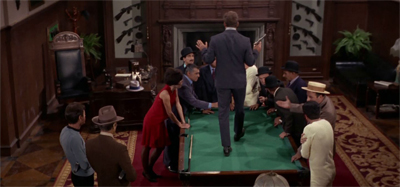
“It’s a very difficult job and the only way to get through it is we all work together as a team. And that means you do everything I say.”
However, A Piece of the Action works spectacularly well. There are a lot of reasons for this. The script is light and witty, moving at an impressive pace with an endearing charm. There is a sense that everybody involved in the show is having a great time. In an interview with Starlog, director James Komack described the atmosphere on set:
Like most good comedy, a great deal of A Piece of the Action was improvised, particularly the Fizzbin card game played by Captain Kirk and a group of dim-witted gangsters.
“They just sat down and did it,” Komack laughs. “Shatner really thought of this idea, and I embellished it. Since I was a writer, it was very easy to add the corrective to get us onto the next beat.”
There’s a sense that the cast are greatly enjoying the freedom afforded by that looser atmosphere, particularly William Shatner. A Piece of the Action features wonderful supporting turns from Leonard Nimoy and James Doohan, but there is no question that the episode is an showcase for William Shatner.
While Spock gets some great moments (particularly his stern references to the street kid as “young man” or his deadpan instruction to Oxmyx to start dialing), A Piece of the Action basks in Kirk. Kirk gets the episode’s best moments – teaching goons to play “fizz bin”, biting his lip when captured outside Oxmyx’s warehouse, or boasting proudly that “nobody’s going to put the bag on [him] any more.” The last act has Kirk completely in control of the story, and Shatner is loving every single second of the experience.
Shatner’s style has always been theatrical, but the actor has consciously dialed his performance up through the second season, perhaps an attempt to steal back some of the spotlight from Nimoy. A Piece of the Action doesn’t just let Shatner loose, it actively encourages him. Here it isn’t just Shatner turning in a scenery-chewing performance, it is Shatner turning in a scenery-chewing performance as Kirk turning in a scenery-chewing performance. Kirk is basking in this opportunity just as much as Shatner.
In a way, A Piece of the Action is just as iconic and influential as The Trouble With Tribbles. It certainly sets an effective precedent for the franchise’s approach to comedy. The Trouble With Tribbles had Kirk confronting a problem that the Enterprise could not solve, but A Piece of the Action derives a great deal of comedy from throwing Kirk and his crew out of their depth. This would become a standard motif for Star Trek comedy.
More than Tomorrow is Yesterday or Assignment: Earth, a clear line can be drawn between Kirk’s difficulties driving a car in A Piece of the Action and about half the gags in Star Trek IV: The Voyage Home. (Similarly, Spock and Scotty’s difficulties with the vernacular are also recycled for that most-loved feature film.) A Piece of the Action is an episode that realises that Kirk and his crew operate within a very particular fantastical framework, and removing them from that framework is a great source of laughs.
That said, the “fish-out-of-water” here is not temporal in nature. Kirk and his crew are not confused about the trappings of twentieth-century Earth – well, not mostly. Nor is it a case of Kirk and his crew wandering into the real world. Instead, our heroes have literally beamed into another story. They are not looking at Earth as it ever actually existed, but instead intruding on a world governed by narrative principles and theories.
When McCoy remarks on how Sigma Iota II reminds him of Earth, Kirk is quick to correct him. “Home was never like this,” he insists, and he’s correct. A Piece of the Action doesn’t unfold in a world resembling Chicago in the twenties, it unfolds in a heightened gangster movie. “I’ve seen pictures of the old days that look like this,” McCoy responds, and he’s likely correct. This version of Earth only existed in motion pictures or pulp fiction. Kirk and his crew have wandered into a different genre, and it’s telling that Kirk only wins once he starts playing by the rules of that genre.
It is an episode that realises that “fish-out-of-water” comedy is the kind of thing you can do with Star Trek, now that the audience has had a chance to get to know the fish in question. The rules and storytelling tools in a Star Trek story are different from the rules and storytelling tools in the real world – or in another sort of story. Indeed, the “fish-out-of-water” set-up works so well within the Star Trek framework that the writers on Deep Space Nine would apply it for Trials and Tribble-ations.
Of course, A Piece of the Action was one of the episodes to which the Deep Space Nine writing staff originally considered returning for the thirtieth anniversary special. The pitch would have seen Sisko and his crew discovering that the population of Sigma Iota II were now imitating Starfleet, as an extended riff on Star Trek fandom. This was not the first time such an idea was proposed. A Piece of the Action is so beloved among Star Trek writers and fans that Melinda Snodgrass had proposed a similar idea in the early years of Star Trek: The Next Generation.
Ultimately, the franchise never returned to Sigma Iota II, at least not on-screen. In The Magic of Tribbles, Ira Steven Behr explains why Deep Space Nine eventually decided against the original pitch:
“It seemed like a pretty fun idea,” comments Behr. “All these people dressed up in Star Trek uniforms, living by the code of the Federation. But then we started to get paranoid, especially René, who said that he thought it could sound like were making fun of the fans.” While Behr notes that this was never anyone’s intention, he admits that once Echevarria placed the thought in their minds, the story line quickly died.
Still, the spirit of A Piece of the Action can be seen in Trials and Tribble-ations, with little gags like Sisko’s confusion about how communicators work in the twenty-third century or the fact that members of the crew cannot identify Kirk.
There is something quite interesting in that idea, an implication that retroactively makes A Piece of the Action more interesting. At its heart, A Piece of the Action is about Kirk and the crew of the Enterprise engaging with a body of hardcore fandom. It just so happens that this particular fandom has fixated on “Chicago Mobs of the Twenties” rather than something like Star Trek. Sigma Iota II is essentially an entirely planet that is engaging in cosplay and live action role-play.
At the time that A Piece of the Action was written, Star Trek was still discovering its own fandom. The term “Trekkies” had only been coined by Arthur W. Saha shortly before the start of the second season, fanzines were only beginning to spread, and the first campaigns to save Star Trek were being launched. It is impossible for A Piece of the Action to have been cognisant of all this, but it makes the episode all the more potent in hindsight. An episode about devoted fandom from a show that was cultivating its own devoted fandom.
That said, A Piece of the Action is more than just a light episode. It is undoubtedly a comedy caper, and a delightful one at that, but there’s more to it than that. There are points where its observations about the Federation (“the Feds”) seem quite pointed. Sure, it ends with Spock pointing out that Starfleet Command is unlikely to approve of Kirk’s negotiating tactics, but the best jokes have just the slightest hint of truth. Kirk’s suggestion that the Federation is an intergalactic mob might by an exaggeration, it is not entirely disconnected from Coon’s view of the institution.
After all, Arena – the first episode to feature the Federation – portrayed them absent-mindedly intruding into Gorn space, causing a major diplomatic incident and the loss of many lives. The Federation seemed quite expansionist in A Taste of Armageddon. Similarly, Errand of Mercy suggested an equivalence between the Federation and the Klingons; Kirk was just as blood-thirsty as Kor, despite his justifications. Metamorphosis seemed to support the view that the honest love between two people was more important than any Federation business.
There is a sense that many viewers consider Star Trek to be a monolithic entity – that commentators will try to map cohesive morals and themes on to the eighty-episode run of the original Star Trek series. A lot of this is retroactive romanticism, a desire to believe that Star Trek offered an internally consistent vision of the future. This was never the case. Continuity was subject to change from one episode to the next, but also the show’s position on topical issues was just as volatile.
The production team were often more concerned with hammering out story problems or budget issues than ensuring a consistent philosophical approach across the series. Gene Roddenberry seemed to buy into the ideology of the Cold War, with episodes like A Private Little War and even The City on the Edge of Forever insisting that some wars needed to fought. Gene L. Coon was more cynical, dismissing the whole ideological framework in shows like A Taste of Armageddon or Errand of Mercy.
For all that A Piece of the Action is a comedy piece, it is a comedy that is riffing on classic Star Trek themes. As James F. Broderick notes in The Literary Galaxy of Star Trek, the episode uses some stock Star Trek elements:
In the first look at the society of gangsters which populates the planet Kirk and crew visit in A Piece of the Action, everyone is brazenly brandishing a “Tommy gun.” As the viewer soon discovers, this is merely a variation on a common theme in Trek wherein rival factions seek to gain the advantage over their opponent by gaining possession of more potent, more lethal, technology.
It’s very much a stock Star Trek story, to the point where it was originally pitched as a more serious story featuring Kirk and Spock competing against subversive Romulan agents for the fate of the planet. This draft of the episode, Mission into Chaos, plays like Friday’s Child with gangsters instead of medieval iconography and with Romulans instead of Klingons.
The Romulans are entirely absent from the final version of A Piece of the Action. As a rule, John Meredyth Lucas tended to shy away from the traditional Star Trek aliens – in some respects, the new producer tended to push the show’s general atmosphere back towards that of the early first season, before a sense of continuity and world-building had developed during Coon’s tenure. While the Romulans were seriously under-used on the classic Star Trek, dropping the aliens from A Piece of the Action is a very clever move.
It is worth noting that all of the remaining “interference” stories in the second season – including Patterns of Force and The Omega Glory – blame the Federation or Starfleet for meddling in the affairs of these cultures. There are no more convenient meddling Klingons like Krell or Kras. A Piece of the Action marks a sharp change in direction for the series, and one that seems like a turn away from the politics of Friday’s Child and A Private Little War.
Indeed, a lot of A Piece of the Action plays as a knowing parody of A Private Little War. The local gangsters are looking for the kind of support that Kirk offered Tyree. “I got to make hits,” Oxmyx explains in a matter-of-fact manner. “I want you to help me hit them. That’s all.” By the time that Kirk crosses paths with Krako, he knows what to expect. “Let me guess,” Kirk begins. “You’ll want heaters, and then you’ll want troops to teach them how to use them.”
While A Private Little War ended with Kirk providing Tyree and his people with rifles, A Piece of the Action ends with a slightly more optimistic (albeit playful) resolution. Kirk brings the gangs together for a singular purpose – actually engaging with the inhabitants of the planet on a meaningful level (and on their own terms) instead of simply stoking the fires of conflict. Sure, the situation is a little different than it was on Tyree’s planet due to the absence of the Klingons, but it’s still a more reasonable solution.
In Gilligan Unbound, Paul A. Cantor suggests that A Piece of the Action could be seen as a criticism of the Cold War as an ideological conflict, wryly mocking the sort of flag-waving chest-beating politics that Roddenberry would write into his own scripts for the series:
This is one of the more amusing episodes in the history of the series, but it has potentially serious undertones. It seems to reduce the ideological conflicts the series normally presents (democracy versus autocracy) to mere gang warfare – with each side simply grabbing for its “piece of the action.” The suggestion seems to be that the two sides in the Cold War may be no better than gangsters themselves.
This is pretty consistent with Coon’s perspective of the Cold War. Classic Star Trek has tended to portray the Federation as an extrapolation of contemporaneous American values into the distant future – Kennedy’s “new frontier” on a galactic scale. Roddenberry seems to think this is a good idea; Coon is less certain.
Kirk’s solution to the problem is decidedly tongue in cheek, but plays as a wry critique of Federation foreign policy as suggested in Errand of Mercy. Boss Kirk makes the local crime lords an offer they can’t refuse. “The planet is being taken over by the Federation, but we don’t want to come in here and use our muscle, you know what I mean?” he asks, rhetorically. “That ain’t subtle. So what we do is we help one guy take over the planet. He pulls the strings, and then we pull his.”
Despite Kirk’s flippancy, this is a fairly succinct summary of the political realities of the Cold War, where both major powers sought to shore up their own position by installing friendly regimes and enabling sympathetic political movements. Gene L. Coon’s Federation would seem to have adopted a similar approach. A Taste of Armageddon is about the Federation’s attempts to secure a strategically important friendly port, regardless of what the natives want. Errand of Mercy has Kirk trying to force the Organians into an alliance with the Federation ahead of the Klingons.
In a way, A Piece of the Action plays as a light-hearted criticism of capitalist democracy. Although Sigma Iota II has built a society based about criminal enterprise, the planet has developed a system of government that feels somewhat analogous to contemporary America. The language may be slightly different, but A Piece of the Action suggests that the mechanics themselves are uncannily similar.
It turns out that Oxmyx is more than a local hood – he’s the leader in charge of the local community. Escorting the Starfleet officers to a meeting with Oxmyx, Kalo finds himself hassled by angry constituents. “Hey, when’s the boss going to do something about the crummy street lights around here, eh?” one local woman demands. “A girl ain’t safe.” Another chimes in, “And how about the laundry pickup? We ain’t had a truck by in three weeks.”
There’s a sense that this works quite similar to representative democracy. Confronted with this dissatisfaction, Kalo suggests, “Write him a letter.” One of the constituents protests, “Listen, we pay our percentages. We’re entitled to a little service for our money.” That is how the system works. “We pay our percentages and the boss takes care of us.” This protection racket appears to be taxation in all but name.
Sigma Iota II has built a system of government based on organised crime, and it looks a lot like representative democracy. Of course, gangsters could be said to embody a warped (and almost romantic) sense of American individualism – rugged characters who are essentially “self-made” in a hyper-competitive world. Given how quintessentially American the idea of “the gangster” is, it makes sense that a culture built around that iconography would resemble America in some rather pointed ways.
There is a sense that Coon is having a bit of fun with the idea of Star Trek. A Piece of the Action is a comedy, but is a comedy that affectionately riffs on the trappings and the internal logic of a Star Trek story – subversively and wryly playing with audience expectations and teasing the audience’s familiarity. Even the gangster setting feels like an excuse to play with the core narrative of Star Trek as a whole.
Star Trek has been described as “Wagon Train to the stars”, and there is a clear sense that the show is inspired by the American frontier narrative. Star Trek can be effectively classified as a space western, an idea that Gene L. Coon would play with even more explicitly in The Spectre of the Gun in the third season. It’s no wonder that Kirk makes such an effective gangster – even discounting his driving skills. After all, Kirk is a cowboy in space, which is a similar archetype to the classic gangster.
As Barry Langford suggests in Film Genre, the gangster and the cowboy are very similar pop culture archetypes:
As Neale notes, the film gangster like the Western hero has often been discussed in socially symptomatic terms; in fact, the gangster is frequently received as the Westerner’s urban mirror image, enacting the conflicts and complexities of an emergent urban modern imaginary as the cowboy enacts those of a residual agrarian myth. Like the Westerner, the gangster and his values have been embedded in a fairly stable thematic and iconographic universe established and consolidated through decades of reiteration and revision, and a certain masculine style and the elaboration of a code of behaviour through acts of decisive violence are central concerns in both genres. A number of writers draw parallels between the two genres: McCarty describes the gangster as ‘the modern continuation of the Western – a story the Western had grown too old to tell.’
The idea of having Star Trek cross over from futuristic western to classic gangster film is an inspired twist.
In fact, A Piece of the Action rather skilfully transposes familiar western and Star Trek plot elements into the gangster setting. Kirk and his crew ride into town to find themselves caught between two competing forces. Using his wits, Kirk manages to stay alive and out-manoeuvre both parties. However, A Piece of the Action cleverly plays with expectations in having Kirk cast himself not as the captain of a starship or a high plains drifter while taming this chaotic environment, but as a criminal boss.
The plot is so archetypal that it almost plays like a Star Trek adaptation of A Fistful of Dollars, with a gangster twist. Then again, the basic plot of A Fistful of Dollars is so archetypal that it was originally a samurai film (Yojimbo) and later adapted as a gangster film set in the thirties (Last Man Standing) while still retaining its core essence. A Piece of the Action offers a delightfully gonzo reflection of the archetypes that exist at the very heart of Star Trek.
It is worth noting that – at the time that A Piece of the Action was written and broadcast – the gangster film was largely considered a spent force in American pop culture. While the Western was still going strong, gangster films were still awaiting their resurgence, as Nicole Hahn Rafter reflects in Shots in the Mirror:
About 1940 the gangster film entered a period of relative dormancy, one brought on by America’s involvement in World War II and the decreasing relevance of the Great Depression. For the next two decades, mobsters appeared mainly ins secondary roles or as desperate, aging representatives of a dying breed, as in Raoul Walsh’s High Sierra and Key Largo. In High Sierra, Humphrey Bogart stars as a middle-aged gangster trying to do one last job before retiring to an honest life. The honourable mobsters of his generation, who killed only when double-crossed, are being replaced by a younger brasher type. His last stand in the mountains, outnumbered and outgunned, is thus emblematic of the decline not only of traditional gangsters but also of the gangster film itself.
The type of gangster film that Kirk wanders into is particularly old-fashioned, harking back to the thirties and forties rather than forward towards the revival of the genre in the seventies. It is specifically modeled on Chicago of the 1920s, full of bright colours and broadly-drawn archetypes.
Although it is hard to imagine, there was a point in recent memory where the gangster movie was in decline – where the genre was less popular and successful than the western. However, by the late sixties, the gangster film’s heyday was considered a distant memory, as Keith M. Booker observes in The Historical Dictionary of American Cinema:
Few gangster films were produced in the 1940s and 1950s, when the world of criminality was primarily through film noir. However, some noir films, such as Raoul Walsh’s White Heat, could also be considered gangster films. Meanwhile, 1960s films such as Bonnie and Clyde did depict criminal gangs but were still more concerned with the depiction of their protagonists as individualist outlaws rather than as organised gangsters. The genre did not see a real resurgence until the appearance of Francis Ford Coppola’s The Godfather, a landmark film that raised the gangster genre to the level of high art, while depicting its organised criminals as real human beings with considerable psychological depth and complexity. When Coppola followed with the equally successful The Godfather: Part II in 1974, it was clear that the genre had great potential both for the depiction of human drama and for social and political commentary, as the line between ‘legitimate’ business and criminal enterprise was increasingly shown to be a fine one.
So A Piece of the Action was playing with a genre that was – at the time – considered to be a lot less viable than westerns or science-fiction. Perhaps this sense of distance allowed Gene L. Coon to have a bit more fun, to use the pulpy genre as a vehicle to explore contemporary America in a way that would be more difficult with a more vibrant and dynamic genre like the western.
After all, Oxmyx is a particularly stinging reflection of the type of rugged American individualism and exceptionalism, exaggerated to an absurd degree. Justifying his violence and brutality, Oxmyx offers Spock an important lesson in the way the world works, “Nobody helps nobody but himself.” Spock finds it quite difficult to understand Oxmyx’s motivations. “You yourself have stated the need for unity of authority on this planet,” he observes. Oxmyx responds, “Yeah, but I got to be the unity.”
A Piece of the Action portrays this sort of individualism and exceptionalism – a feature common to the archetypal cowboy and the classic gangster, and also part of the traditional narrative of the American Dream – as a clear weakness that holds back Sigma Iota II. Oxmyx and his fellow gangsters need to get past this particular hang-up. They need to come together and work together in a way that puts aside their own petty bids for power. For all its broad comedy, A Piece of the Action is also somewhat pointed in its use of these archetypes.
A Piece of the Action is a comedy episode that – like The Trouble with Tribbles before it – is as brilliant as it is clever. It’s hilarious and fun, a wonderful demonstration of just how charming Star Trek could be. At the same time, there’s just the right amount of cynicism and reflection buried at the heart of the joke. It is a reminder of just how sorely Gene L. Coon will be missed.
You might be interested in our other reviews from the second season of the classic Star Trek:
- Catspaw
- Metamorphosis
- Friday’s Child
- Who Mourns for Adonais?
- Amok Time
- Supplemental: Spock’s World by Diane Duane
- The Doomsday Machine
- Supplemental: New Visions #3 – Cry Vengeance
- Wolf in the Fold
- The Changeling
- The Apple
- Supplemental: (DC Comics, 1984) #43-45 – The Return of the Serpent!
- Supplemental: (IDW, 2009) #13 – The Red Shirt’s Tale
- Mirror, Mirror
- Supplemental: Deep Space Nine – Crossover
- Supplemental: New Visions #1 – The Mirror, Cracked
- Supplemental: (DC Comics, 1984) #9-16 – New Frontiers (The Mirror Universe Saga)
- Supplemental: Mirror Images
- Supplemental: Mirror Universe – The Sorrows of Empire by David Mack
- Supplemental: (IDW, 2009) #15-16 – Mirrored
- The Deadly Years
- I, Mudd
- Supplemental: (Gold Key) #61 – Operation Con Game
- Supplemental: (DC Comics, 1984) #39-40 – The Return of Mudd
- The Trouble With Tribbles
- Supplemental: The Galactic Whirlpool by David Gerrold
- Supplemental: Alien Spotlight – Tribbles
- Bread and Circuses
- Journey to Babel
- A Private Little War
- The Gamesters of Triskelion
- Obsession
- The Immunity Syndrome
- A Piece of the Action
- By Any Other Name
- Return to Tomorrow
- Patterns of Force
- The Ultimate Computer
- The Omega Glory
- Assignment: Earth
- Supplemental: Assignment: Eternity by Greg Cox
- Supplemental: (DC Comics, 1989) #49-50 – The Peacekeepers
- Supplemental: (IDW, 2008) Assignment: Earth
Filed under: The Original Series | Tagged: capitalism, Chicago, Cold War, dan p. harmon, exceptionalism, Feds, gangsters, Gene L. Coon, gene roddenberry, imperialism, individualism, kirk, meta-fiction, mob, star trek, star trek: the original series, stories, tos, William Shatner |















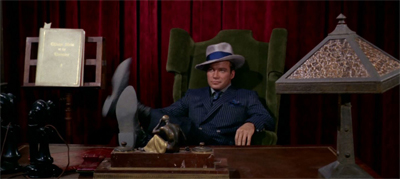
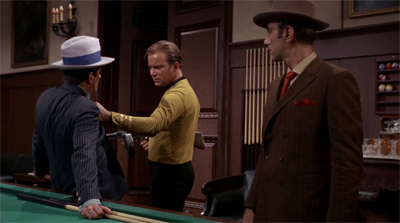
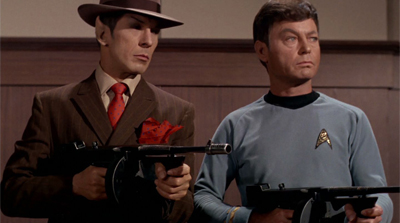
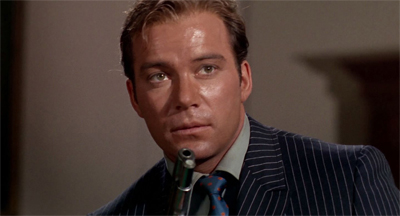
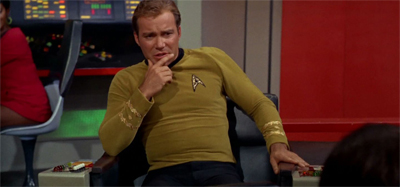
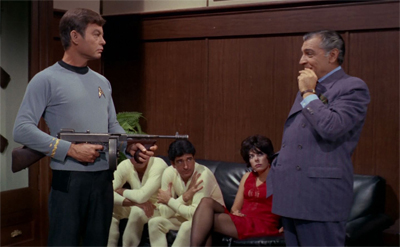
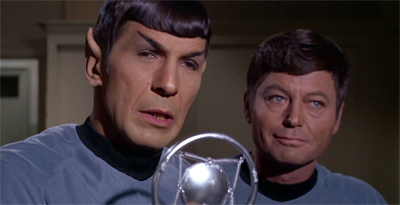
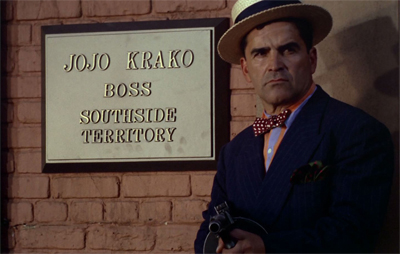
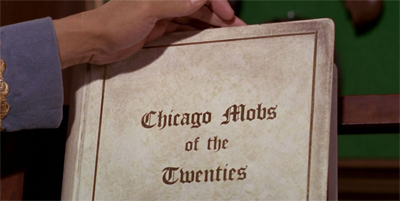

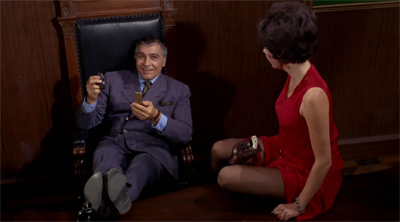


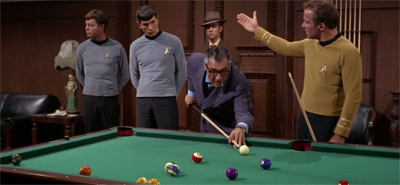
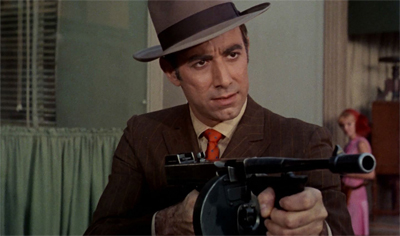
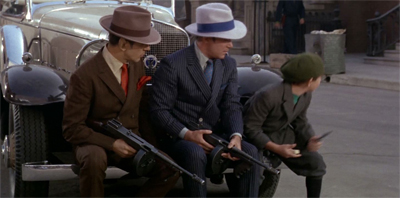
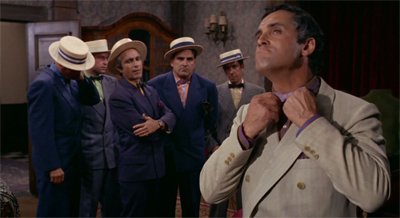
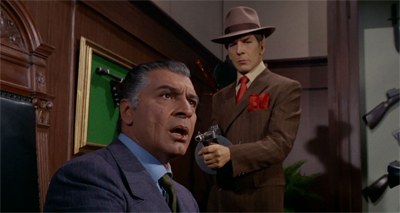
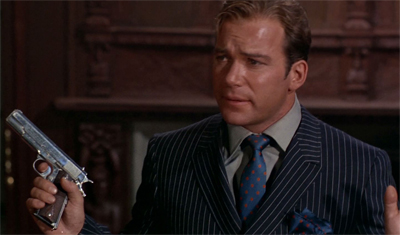
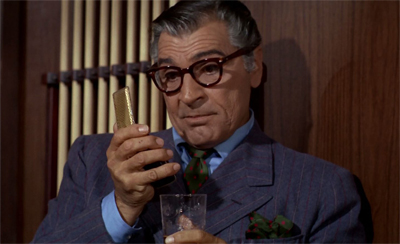

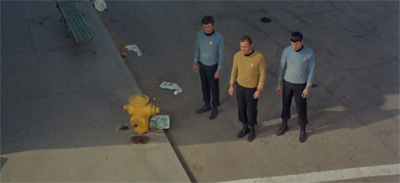

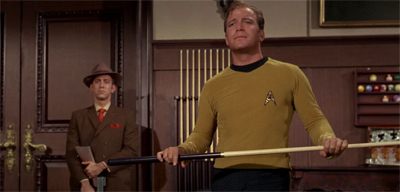





“This is one of the more amusing episodes in the history of the series, but it has potentially serious undertones. It seems to reduce the ideological conflicts the series normally presents (democracy versus autocracy) to mere gang warfare – with each side simply grabbing for its “piece of the action.” The suggestion seems to be that the two sides in the Cold War may be no better than gangsters themselves.”
I think a big reason for the popularity of the gangster genre is that it allows you to make movies about power, about leadership, about conflict, about the rise and fall of empires, et al… which completely strip away all the ideological bullshit that would come with it if this were anything else. It’s become cliche to say that “The Godfather” is trying to talk about the dark side of the American Dream and free enterprise or that its main characters are like the Kennedys, but if the movies were speaking directly about these things, they’d not only be more controversial, but less timeless and universal. As it is, there’s no pretense that it’s about anything more than money and power (and more unquantifiable human motives, like wanting to be the big fish in the pond rather than one of the little ones being bossed around). So you can relate it to any kind of human activity that touches on these things… and yet leave behind all the baggage that would come with your movies if they were directly about the Cold War, or free enterprise, or the Kennedys. It’s about all of these things, and none.
Very good point. I also think that there’s a vicarious thrill to the gangster genre as well, even if that makes me sound horribly puritan. 🙂
But very fair point. Luckily I can never be accused of reading too much into a television show, right? 😉
This is just an addendum to what Chris said… Part of the American experience, I find, is that anti-authoritarians always turn to authoritarians for guidance in the end. It’s nothing unique to us (all power systems do this), but we int he states have this great feeling of independence, so it’s even more dramatic. Gangsters feed on a naive mistrust in “the system” and trust in “neighborhood protectors” who know them by name. Libertarians prefer a “free market” controlling their lives over a representative government. New Yorkers identify more with an unaccountable police force than they do with the Mayors they elect. The list goes on.
Thanks Ed!
Writing these reviews, I am occasionally worried I might seem a little too critical of the US. Certainly Ireland can cast few stones in these regards, but it’s not really relevant to the context of most Star Trek.
Most of the reviews I’ve read of this episode are so taken in by the comedy that they don’t notice the underlying themes or issues. Thanks (as always) for your delightfully thoughtful and insightful review.
And thanks for the kind words!
To be fair, there is a wealth of material to draw on here. I’m standing on the shoulders of giants. That’s the beauty of TOS, it has been analysed and discussed time and time again, so there’s a lot of pre-existing work to draw upon. (It also makes Voyager and Enterprise so much fun, because they are comparatively under-explored.)
One small nit, the franchise actually did return to Sigma Iotia II in the 25th anniversary console video game for the original Nintendo Entertainment System. The game took several plot points from several shows and mashed them together. It even had a cameo with a Gorn from “The Arena.”
But is should be noted, that the little cliffhanger moment with McCoy’s communicator was the central plot to that video game narrative. The Iotians learned the technology, and created a machine that created serious space-time disturbances that throws the Enterprise for a loop. In the end, the crew has to go back in time to recover Bones’ communicator from the Iotians.
Not the best story line written, but better than the first half of season 1 of TNG.
That being said, a fun way the franchise played into another genre for a week. Something would be ridiculous today, but almost a necessity in the three-network television landscape from the 1960s.
Not really impressed by this episode. I think it would have worked better if it had been a time travel episode.
I don’t know. I loved TOS’ ability to embrace surrealism and absurdity in its storytelling.
Actually, you could almost say this episode brings the idea of playing two criminal gangs against each other full circle. “Yojimbo” has been noted as an uncredited adaptation of “Red Harvest”, a story by Dashiell Hammett where his character, the Continental Op, pits two warring gangs fighting to control a town in the 1920’s against each other.
Ha! Good spot.